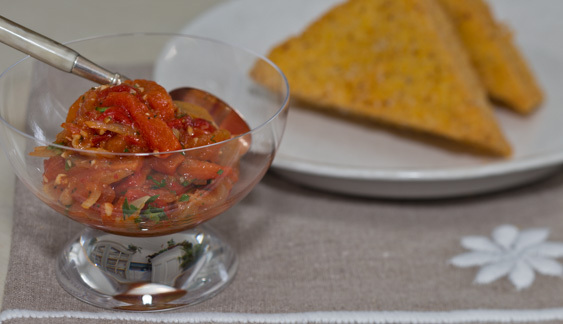Piperade

introduction
Piperade is a bold Basque sauce/condiment, brilliantly red and glossy—just what you’d expect from a terroir that offers hot sun and rich soil. In addition to its allium base notes (onions and garlic) and its nightshade heart (bell peppers and tomatoes), piperade seeks gentle heat from chile, particularly one known as piment d’Espelette.
We acknowledge forthrightly our distaste for green bell peppers, which, in this country at least, run gnarly to disagreeable. Over objections (“It might be too sweet!”), we went all out with red peppers offset with a spark of dried piment d’Espelette—and discovered, gratefully, the piperade was not too sweet at all. Rich, yes. Unctuous, yes. But not too sweet.
Cooking Remarks
Dried piment d’Espelette is produced from an eponymous small red Basque pepper. It has a fruity, sweet taste with a touch of heat and tobacco in the back, all of which offset the piperade most favorably. You may purchase dried piment d’Espelette on Amazon or at Oliviers & Co.
Because we use this piperade as a condiment, we recommend reducing more liquid from the mixture in the final phases of cooking than might be customary. Do as you wish this one, folks: there is no wrong way.
equipment mise en place
For this recipe, you will need a chef’s knife, a paring knife, a large rimmed baking sheet, a medium bowl, a fine-mesh strainer set over a bowl, an 11-inch sauté pan (or similarly sized skillet), and a wooden spoon.
-
-
2pounds red bell peppers
-
12ounces ripe plum tomatoes
-
3tablespoons extra-virgin olive oil
-
1medium onion, sliced thin lengthwise
-
Fine sea salt and freshly ground black pepper
-
4garlic cloves, minced
-
1teaspoon minced fresh thyme leaves
-
¾teaspoon piment d’Espelette
-
1small bay leaf
-
2tablespoons minced fresh flat-leaf parsley
-
-
Adjust the oven rack so that it is positioned about 3 inches from the broiler. Heat the broiler.
-
With a chef’s knife, lob off the top and bottom of each pepper and cut it in half lengthwise; discard the tops and bottoms. Use a paring knife to trim the ribs from each half and remove the core. Lay each pepper half skin side up and press on it with your palm to flatten it. Arrange the flattened pepper pieces in a single layer on a large rimmed baking sheet.
-
Broil the peppers until the skins are bubbled and blackened, 5 to 15 minutes, rotating the baking sheet halfway through; the cooking time will depend on the intensity of the broiler, so monitor closely. Meanwhile, core the tomatoes, cut each one in half lengthwise, and push out the seeds with your fingers. When the peppers are ready, immediately transfer them to a medium bowl and cover tightly so that they steam and the skins loosen. Set the tomato halves cut side down on the now-empty baking sheet and broil until the skins are charred and loosened, about 5 minutes, rotating the baking sheet about halfway through. Let cool on the baking sheet.
-
When the peppers are cool enough to handle, peel and discard the skins. If your peppers are very long, cut each piece in half crosswise, and then cut into ¼-inch-wide strips. Peel the tomatoes and dice them finely. Put the diced tomatoes into a fine-mesh strainer set over a bowl to allow excess juice to drain off.
-
In an 11-inch sauté pan (or similarly sized skillet) over medium heat, warm the olive oil until shimmering. Add the onion and ¼ teaspoon of salt and cook, stirring occasionally with a wooden spoon, until the onion is fully softened but not browned, 10 to 12 minutes. Add the garlic, thyme, piment d’Espelette and cook, stirring constantly, until the garlic is no longer raw, about 2 minutes. Add the roasted peppers, the drained tomatoes, 2 tablespoons of the tomato juice, the bay leaf, ¾ teaspoon salt, and ¼ teaspoon of pepper and stir until well combined. Bring the mixture to a simmer over medium-high heat, and then turn down the heat to medium-low to maintain a gentle bubbling action. Cover partially and cook until the flavors have melded and much of the moisture has cooked off, about 15 minutes (fig 5.1). Taste for seasoning, remove and discard the bay leaf, and stir in the parsley. Serve hot, warm, or at room temperature. (Piperade can be refrigerated for up to 5 days in an airtight container; reheat gently before serving.)